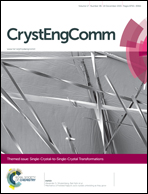Anion triggered and solvent assisted structural diversity and reversible single-crystal-to-single-crystal (SCSC) transformation between 1D and 2D coordination polymers†
Abstract
An anion induced structural variation from 1D to 2D was studied for four coordination polymers (CPs) synthesized from an angular ditopic ligand 2,6-bis(imidazol-1-yl)pyridine (pyim2) under different solvent conditions, namely {[Zn(pyim2)2]·(PF6)2}n (1) (1D), {[trans-Cd(pyim2)2(DMF)2]·(PF6)2·(DMF)2}n (2) (1D), {[trans-Cd(pyim2)2(H2O)2]·(NO3)2}n (3) (2D) and {[trans-Cd(pyim2)2(H2O)2]·(PF6)·(NO3)·(H2O)2}n (4) (1D). An anion triggered single-crystal-to-single-crystal (SCSC) transformation was observed from 1D to 2D by counteranion exchange from PF6− to NO3− and vice versa. In addition, the cause for SCSC transformation involving the metal–ligand bond breaking/formation phenomenon and enhancement/decrement of the network dimensionality is discussed. The anion/solvent exchange transformations were confirmed directly through single crystal X-ray diffraction, IR spectroscopy, PXRD and elemental analysis. Furthermore, the thermal and solid state photoluminescence properties of 1–4 were analyzed.

- This article is part of the themed collection: Single-Crystal-to-Single-Crystal Transformations

 Please wait while we load your content...
Please wait while we load your content...